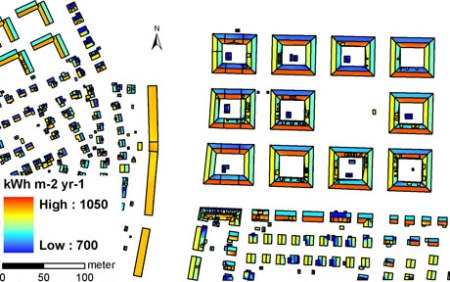University of Gothenburg researchers have developed a tool dubbed as Solar Energy from Existing Structures (SEES) that utilizes real conditions to detect the optimum magnitude of solar incidence possible on a specific roof, a neighborhood or in an entire town.
 The new SEES tool provides a map of the solar efficiency of individual roofs, based on their surroundings. Warmer colours show where the solar irradiance is highest. The figure shows the old Härlanda jail and its surroundings, and it has been produced by SEES.
The new SEES tool provides a map of the solar efficiency of individual roofs, based on their surroundings. Warmer colours show where the solar irradiance is highest. The figure shows the old Härlanda jail and its surroundings, and it has been produced by SEES.
The university researchers in partnership with consultants of WSP Analys & Strategi have developed the geographical information system (GIS)-based tool to measure the possibility of actual roofs to generate energy using solar panels. The novel tool will be offered to both the municipalities and companies free of cost.
The computer-based, GIS collects, records, investigates and delivers geographical data. Thus, SEES illustrates actual roofs in the exact surroundings. The three-dimensional built surroundings are illuminated by the sun in the model, simulating the shadowing by the surrounding plants, terrains and buildings.
The shadow effect can be measured for every month or for a whole year, hence some parts of a roof are not suitable for capturing energy from the sun, although the roof has both optimal gradient and direction. In this method, the total solar radiation on every portion of a roof in a specific area can be calculated in terms of kWh/sq m. Hence, SEES can offer a guide on the suitability depending on the user’s needs for poor, good and better annual solar incidence.
In order to get a precise estimate of the solar incidence, climate data with a resolution of up to 1 h is utilized for the site, where SEES is being utilized. Gothenburg has been used as the pilot town in the research project funded by the Region Västra Götaland County Council, the City Planning Administration of Gothenburg, the Research Foundation of Göteborg Energi and the SolEl program.
Source: http://www.gu.se